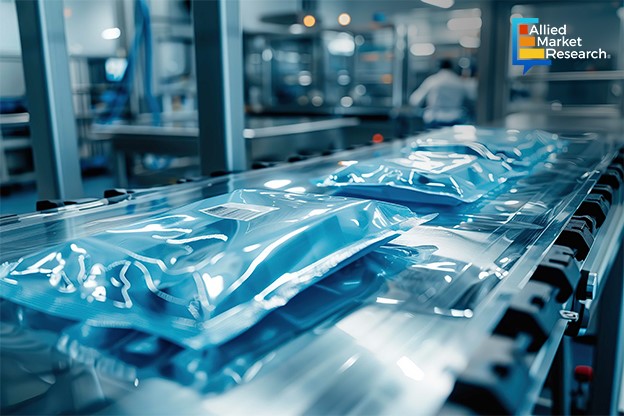Innovations in Flexible Packaging: Enhancing Sustainability and Brand Appeal across Modern Industries

6 Jan
2025
Highlights:
- A brief on flexible packaging
- Modern materials used in flexible packaging
- Growing importance of flexible paper packaging
- Notable acquisitions made by industry players
In the rapidly evolving consumer market, companies are increasingly focused on finding innovative packaging solutions that give improved protection to products, enhance brand appeal, and promote sustainability. Flexible packaging has emerged as a versatile and adaptable packaging format that rapidly transforms various industries. This new type of packaging encompasses any type of packaging made from non-rigid materials that easily adapt to the shape of the products they hold.
Flexible packaging utilizes a range of flexible materials, such as foil, plastic, and paper, to produce pouches, bags, and other adaptable containers. It comes in various forms such as pouches, bags, sachets, wraps, roll stock, and lidding films, serving a wide array of product applications. This packaging approach is especially beneficial for versatile industries, including food and beverage, personal care, and pharmaceuticals.
Popular flexible packaging materials
Materials play an important role in enhancing the effectiveness of flexible packaging. Plastics, aluminum foil, and paper are materials that are commonly used in this packaging. The selection of material significantly influences the package's performance, cost, and environmental impact.
Plastics such as polyethylene, polypropylene, and polyethylene terephthalate are renowned for their strength, lightweight nature, and barrier properties. As a result, plastic films are extensively utilized in the food industry for packaging snacks, frozen meals, and perishable items due to their outstanding moisture barrier capabilities and versatility.
Moreover, aluminum foil provides outstanding barrier properties against light, oxygen, and moisture, making it an excellent choice for sensitive products. In the pharmaceutical sector, aluminum foil is commonly used to package capsules and tablets because it provides unparalleled protection against external contaminants.
In addition, paper is a favorable material for packaging due to its biodegradability and often works in conjunction with other materials to improve its barrier properties. Paper-based packaging is gaining popularity for dry goods and as an outer layer due to its recyclability and renewable characteristics.
Reasons why flexible paper packaging is gaining huge traction
Flexible paper packaging products are free from materials such as silicone, glassine, and laminations, resulting in a lightweight design weighing under 100 grams per square meter. These characteristics enhance their environmental friendliness, lower overall shipping costs, and improve logistics efficiency. The demand for these solutions has increased across multiple industries, including chocolates, pet food, personal hygiene products, and prepared meals.
Furthermore, increasing demand for sustainable packaging has made flexible paper packaging a highly attractive option. More brands are acknowledging the advantages of paper-based packaging over traditional plastics. This material is durable, safe for food contact, and offers easy printing options, including both digital and analog printing technologies. Its versatility allows it to meet various packaging needs, such as pouches, flow wraps, and bags, providing significant flexibility for manufacturers.
Flexible packaging options that are creating lucrative opportunities in the sector
Produce bags, a widely used form of flexible packaging, are extensively utilized for fruits and vegetables. These bags are made from materials such as polypropylene, LDPE, or HDPE, suitable for items like tomatoes, grapes, and blueberries. They are designed for greater durability and ease of handling, effectively preserving the freshness of the food items.
On the other hand, vented sealed produce pouches represent another innovative solution in flexible packaging. These clear plastic pouches are perfect for storing and showcasing fruits such as grapes, and vegetables. The vent holes ensure optimal ventilation, helping to keep the food fresh and visually attractive. Moreover, these pouches are designed to be tear-resistant and feature a gusseted bottom for added stability.
In addition, clamshell containers are the preferred option for items like strawberries and blueberries. These vented, clear plastic containers offer excellent visibility and protect against condensation, effectively preserving the quality of the food items. The secure closure mechanism of the containers guarantees that the contents stay intact during transportation. The rise of these promising packaging solutions has fueled the growth of the flexible packaging industry in the last few years.
Toppan Holdings and Sonoco joined forces to enhance flexible packaging solutions
In December 2024, Toppan Holdings, a Japanese global printing company announced its acquisition of Sonoco Products Company, an American provider of consumer packaging. This agreement has enabled Sonoco to expand its thermoformed and flexible packaging businesses in North and South America by implementing the technical expertise and manufacturing capabilities of Toppan’s global packaging business. In addition, this acquisition has complemented Sonoco’s offerings by combining a robust sales network, customer base, and solution development potential. Moreover, through this joint venture, the companies together envision accelerating the development of sustainable packaging solutions to meet emerging consumer needs and give value to their shareholders.
Summing up
The flexible packaging industry is continuously evolving, propelled by innovations in material science, advancements in printing technology, and an increasing emphasis on sustainability. Moreover, advancements in multi-material laminates and antimicrobial packaging to reduce bacterial growth are expected to create wider growth opportunities for the landscape in the coming years.
To gain more insights into the emerging trends in the flexible packaging industry, feel free to reach out to our industry specialists today!

Rosy Behera
Author's Bio- Rosy Behera holds a bachelor’s degree in Electrical and Electronics Engineering and now she is a content writer by profession. She loves to portray her thoughts and ideas with a nice command of words. Grabbing an audience with her creative write-ups is one of her biggest assets so far. Apart from writing, she is a certified “Odisi” dancer and has done Gardharva in Drawing, Painting, and Arts. She always explores new things through travel and is a big foodie.
Avenue: Entire Library membership of Allied Market Research Reports at your disposal
- Avenue is an innovative subscription-based online report database.
- Avail an online access to the entire library of syndicated reports on more than 2,000 niche industries and company profiles on more than 12,000 firms across 11 domains.
- A cost-effective model tailored for entrepreneurs, investors, and students & researchers at universities.
- Request customizations, suggest new reports, and avail analyst support as per your requirements.
- Get an access to the library of reports at any time from any device and anywhere.
Related Post
-
How are Submarine Cables Transforming Global Connectivity with Enhanced User Experience?
-
Endoscopy Procedures: Transformations in Techniques and Applications
-
AI-Powered Video Analytics: How the Product Actually Works for enterprises
-
Painting Robots: Transforming Precision Coating and Creative Applications
-
Innovations in Pharmacovigilance Systems Advancing Patient Safety
-
Understanding Edge Security: Keeping Data Safe Near the Source
-
Exploring the Use and Advancements of 3D Laser Scanners in Professional Applications
-
Reinforcing Industrial Controls with Smarter Tools and Training








